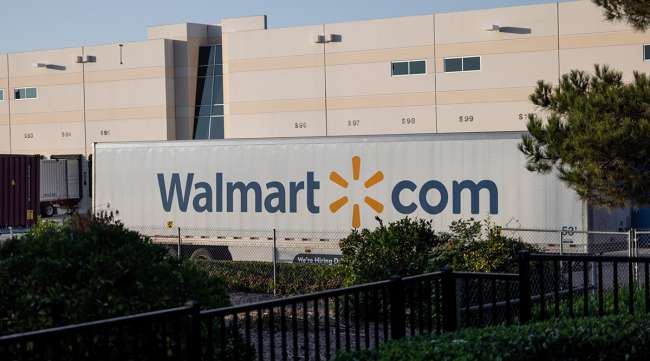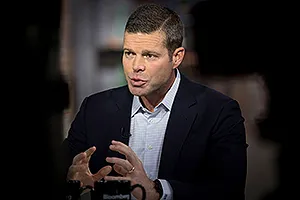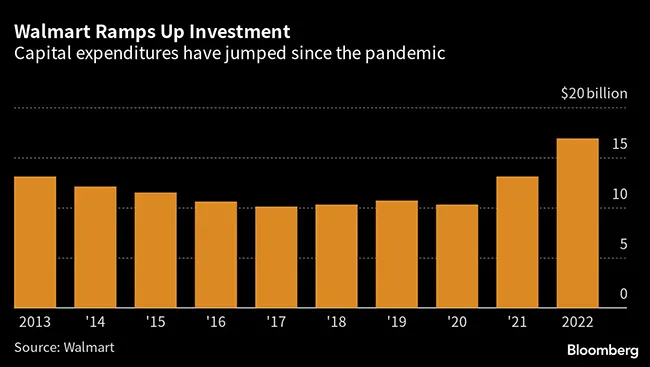Bloomberg News
Walmart Bets on Automation, Dangles Profit Potential

[Stay on top of transportation news: Get TTNews in your inbox.]
Walmart Inc. is betting on greater supply chain automation and hinting that a recent investment binge might lift profit beyond the retailer’s stated long-term goals.
Within three years, the unit cost of moving goods will fall 20% as warehouse robots play a larger role in speeding goods to customers, Walmart said in a statement April 4. While the company reiterated its outlook for this year and the longer term, the opportunity to boost operating income “could be better than what we’ve outlined,” said Chief Financial Officer John David Rainey.
The world’s largest retailer is trying to show off its long-term earnings potential to Wall Street after ramping up capital expenditures in recent years to keep pace with Amazon.com Inc. and other rivals. Walmart says its revamped supply chain will enable it to ease cost pressures tied to the rise of e-commerce and help end a decade of stagnation in U.S. operating income.

Rainey by David Paul Morris/Bloomberg News
“The investments we’ve made have positioned us well and stand to generate steady and sustained growth at higher margins,” Rainey said in the statement, which Walmart released during the first of two days of meetings, store tours and warehouse visits with financial analysts.
Shares fell 0.5% in after-hours trading in New York, as the steady outlook foiled speculation that the company might boost its long-term target for profit growth. Walmart climbed 3.8% this year through the April 4 close, trailing the 6.8% advance of the S&P 500 index.
Walmart pointed to a blueprint for the future at a sprawling distribution center in Brooksville, Fla., about 40 miles northeast of Tampa. Inside, where employees used to manually unload cases of goods from truck trailers, autonomous forklifts now do much of the work while people step in to handle problems the machines can’t solve.
“Now I’m watching the robot unload the truck,” said Jose Molina, a veteran employee. He and colleague Allen Hala, who spoke with reporters accompanied by Walmart executives, recalled the old system of physically demanding labor and cumbersome paperwork to track merchandise.
“We used to be exhausted leaving here,” Hala said. “I actually go home and do a lot more now.”

One of Walmart’s 42 ambient-temperature regional distribution centers, the Brooksville building covers 1.4 million square feet, or the equivalent of about 24 American football fields.
Large robots sort cases and send them into a vast network of shelves. A dense storage system enables Walmart to keep more goods in the same floor area before they’re sent out to stores. And scanners record which items are where in an effort to improve inventory accuracy and respond to consumer demand more quickly.
In Brooksville, the automated operation covers about 260,000 square feet, said David Guggina, Walmart’s executive vice president of supply chain. The robotic system will eventually expand to 800,000 square feet, at which point the warehouse’s throughput of goods will be double what it was before.
Walmart has been cutting jobs at e-commerce fulfillment centers this year, as automation picks up and stores handle more digital orders. But employment in the company’s supply chain is likely to hold steady or even grow a bit in the coming years as volumes rise, said Donna Morris, executive vice president of human resources.

Kayne Grau, CEO of Uptake, discusses ways that fleets can use data to prevent expensive truck repairs. Hear the program above and at RoadSigns.TTNews.com.
Increased distribution efficiency is just one piece of the puzzle as Bentonville, Ark.-based Walmart seeks to lift profit. But it’s an important element as e-commerce increases, since online orders are typically costlier to fulfill than in-store sales.
Those pressures, plus heavy investment in the e-commerce supply chain, are a big reason operating income at Walmart’s U.S. unit has largely hovered around the $20 billion range over the last decade even as sales grew by half.
In its statement for the investor day, Walmart reiterated its long-term financial framework, which calls for 4% in annual sales gains and growth in operating profit of more than 4%.
By the company’s own admission, it’s likely to miss the sales goal this year. In the long term, investors will be watching whether Walmart can meet — or exceed, as the CFO suggested — the profit target.
Walmart ranks No. 2 on the Transport Topics Top 100 list of the largest private carriers in North America.
Want more news? Listen to today's daily briefing below or go here for more info:




